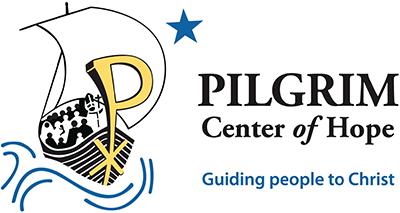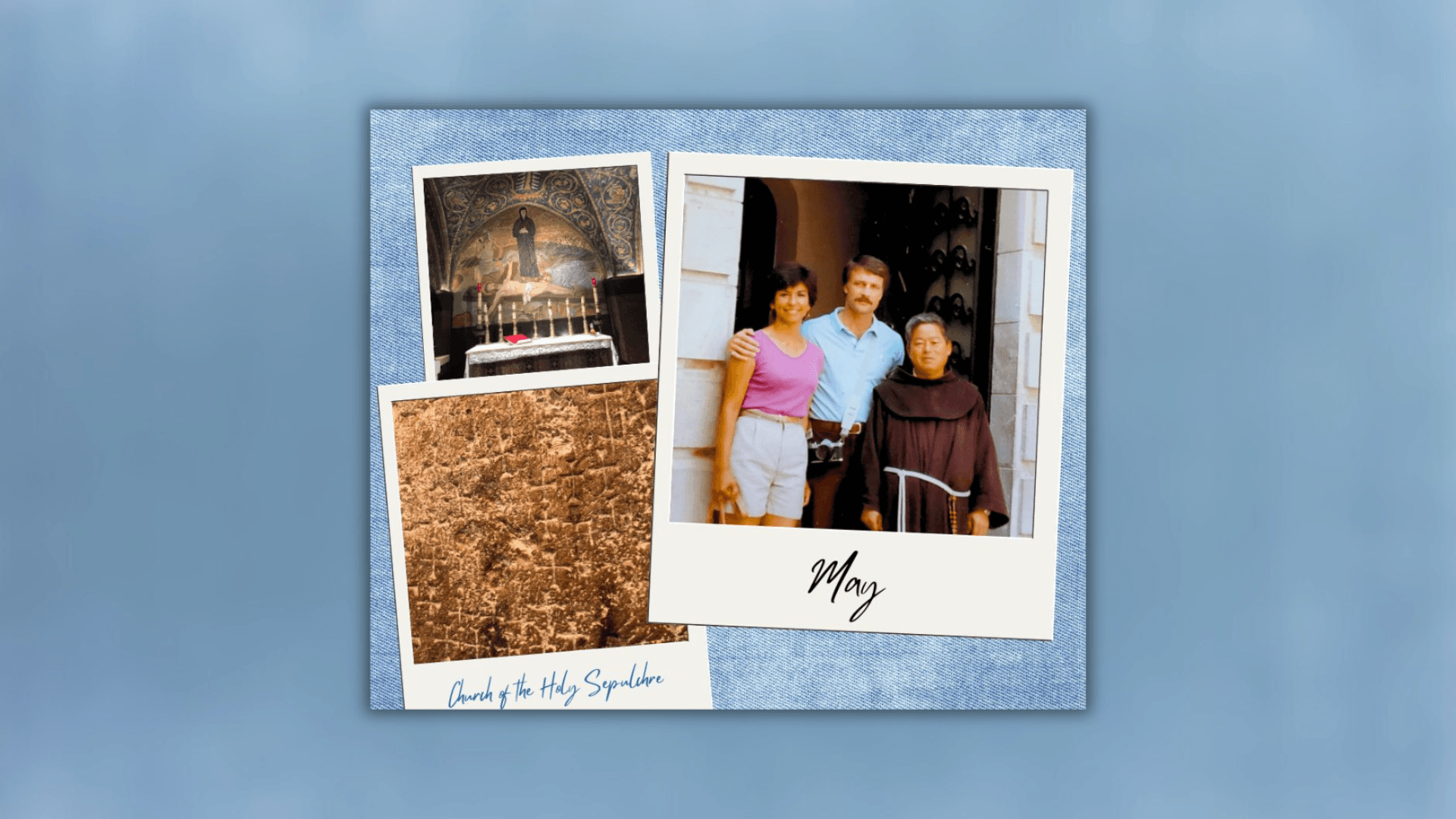In proclaiming the Jubilee Year of Hope (8), Pope Francis writes:
The first sign of hope should be the desire for peace in our world, which once more finds itself immersed in the tragedy of war. […] Is it too much to dream that arms can fall silent and cease to rain down destruction and death? May the Jubilee remind us that those who are peacemakers will be called “children of God” (Matthew 5:9).
1984 – The story of our directors’ first pilgrimage to the Holy Land continues…
Since 1342, the Catholic Church has charged the Franciscans with custodial protection and maintenance of the holy sites in Jerusalem and throughout the Holy Land. At the Basilica of the Holy Sepulchre, the holiest Christian site, it is the duty and privilege of the Franciscans to continuously worship Jesus, Savior and King, on behalf of the universal Church.
Sister Bernarda coordinated with the Franciscans for Tom and Mary Jane Fox to spend time in solitude inside the church. This month, we join their experience inside this church built over Calvary and the Tomb of Christ, and discover how we, the Church, are called to be peacemakers.
Mary Jane recalls: To witness the intense focus of these Franciscan priests, concentrating on the Mass so reverent in prayer, meditation and worship at the site of Christ’s Tomb, is to see into the heart of the true disciple of Jesus Christ awed in the presence of God. Joining in this worship with the Franciscans transformed Tom and me. Our shared worship was translated into shared prayer. Together as one we began daily to offer praise, thanksgiving and petition to God for our own needs and for the needs of the world.
The Basilica of the Holy Sepulcher was first built beginning in 326 A.D. under the command of the Roman Emperor and Christian convert, Constantine. Constantine was converted through the encouragement and prayers of his mother, Queen Helena. Queen Helena had a vision of the Holy Cross and felt called to make a pilgrimage to Jerusalem to preserve where Jesus was crucified and buried. Much of the original edifice was destroyed in subsequent Muslim conquests, but some of the foundation, pillars, and walls remain from the 4th century. The church was rebuilt during the First Crusade and re-consecrated in 1149.
Many of the Catholic churches built in the Holy Land on top of holy sites resemble what they commemorate. With the hundreds of gold ornate oil lamps hanging throughout the church, the tiled mosaics, silver icons and marbled altars, the Basilica looks like a castle built for a king; its dark walls and little light also give it the feel of a tomb.
Deacon Tom remembers: We first climb to Calvary. Up a steep flight of stairs located to the right of the main door, we ascend to where a little over 2000 years ago, Jesus was stripped, nailed to a cross, hung for three long hours and died. Calvary, also called Golgotha, place of the Skull, was an abandoned quarry turned execution site.
We kneel in front of the Roman Catholic altar located on the right called the Chapel of the Crucifixion. It is built over where Jesus was nailed to the cross. The tiled floor and colorful painted ceiling contrast the reality of what happened here. A mosaic depicts Abraham being stopped by an angel from sacrificing his son Isaac. Directly above the altar is the mosaic that shows what God planned instead; Jesus lies on the ground atop his Cross. Soldiers nail his hands to the wood. His Mother stands over Him watching. God will provide the sacrifice for our sin: his only Son.
To the left of this altar is the Chapel of Calvary which belongs to the Greek Orthodox. It is covered with hanging candles. Gold and silver decorate the walls. The rock where the Cross stood can be seen behind glass on either side of the altar. The ground can be touched through an opening in the silver disk under the altar.
Separating the Chapel of the Crucifixion from the Chapel of Calvary is the altar of Our Lady of Sorrow placed over the spot where our Blessed Mother stood at the Cross of her Son. Encased in glass on top of the altar is a bust of Mary. The sadness in her eyes pierces the heart, yet her steadfast faith in the victory of her Son also makes her our Model of Hope.
We pray, we kneel, we sit, we meditate, we read Scripture, we contemplate. Under the altar of the Cross, we touch the ground where our Lord’s blood and water poured out. The experience of touching, seeing and just being here draws us into the story of the Passion. Few words are shared for how can we put into words what happened here? Mary Jane and I at times look at one another; eyes filled with tears at God’s mercy for His people, and in particular, for us.
Mary Jane: We descend the stairs and slowly walk around the entire church. Stone walls are covered with Catholic graffiti; thousands of tiny crosses etched by pilgrims who journeyed here centuries before. Each cross is a love story; a symbol of a heart won by God. Imagine the obstacles a pilgrim would have had to overcome to make his or her way across land and ocean, over tough terrain, and rough seas. Imagine the hearts on fire to see where our salvation was won and to pay homage to the One who won it. In one area, a ship has been drawn with the inscription, “Lord, we have arrived.” We long to add our crosses to the wall. Instead, we etch them into our hearts.
Deacon Tom: Mary Jane and I walk into the simple Franciscan chapel of the Blessed Sacrament to pray in the presence of Jesus in the Tabernacle. A Franciscan priest walks in. We had seen him walking around the church praying. He asks, “How have you two come to be here?” He listens to our story and asks, “Would you like me to hear your confession?” We both were willing…and actually quite surprised how providential this opportunity came to us.
Mary Jane: I receive the Sacrament of Reconciliation first. Father is so kind as I unburden my sins. When he offers the prayer of Absolution, I feel the weight of my sins lifted and receive a deep, immense peace. Father asks for my prayers. This surprises me but I remember responding, “Of course, Father. We will pray for you.”
Deacon Tom: After our confessions, Father visits with us. We learn he is from Korea and has been living in the Holy Land for several years. He tells us that for 30 days each year he lives in a cave in the Judean desert. He fasts and offers penance and prayer. I ask, “What do you pray for?” He says, “I pray for the world; I pray for peace and conversion of souls.” He tells us he makes Rosaries and says he wants to give two to us. We are fascinated by this priest. While he leaves to get them, Mary Jane comments, “That still happens? I would never imagine people still go off into the desert to spend days in a cave in prayer!” Father returns and gives me a Rosary made of black beads and Mary Jane a white one made with Mother of Pearl. Both have a Jerusalem cross: the symbol that represents Christ’s five wounds, His call to go out to the four corners of the world, the symbol of the Roman Catholic Church, and the Franciscan order in the Holy Land.
Mary Jane: Father encourages us to pray the Rosary often. We promise we will and then I add, “Pray for us in America, Father.” He responds, “Oh I do, I pray for the conversion of all souls.” Father blesses our Rosaries and leaves us. Tom and I kneel and offer prayers of thanksgiving to Jesus in the Tabernacle.

Being a Christian peacemaker always includes prayers of intercession.
The Catechism of the Catholic Church states:
“Since Abraham, intercession – asking on behalf of another has been characteristic of a heart attuned to God’s mercy. In the age of the Church, Christian intercession participates in Christ’s, as an expression of the communion of saints. In intercession, he who prays looks, ‘not only to his own interests, but also to the interests of others,’ even to the point of praying for those who do him harm” (2635).
The best intercessory prayer is the Holy Liturgy. By participating at Mass, the faithful join Jesus, our Mediator to the Father, interceding for our needs and the needs of our family, the Church, and the world.
Secondly, praying the Rosary is well-documented as an effective way of bringing peace to world situations. Many have testified to how praying the Rosary also brings peace to personal ones. In praying the Rosary, we join our prayers with the Virgin Mary, the Mother of God and our Blessed Mother, whose one mission is to bear Jesus in souls so as to raise children of God.

